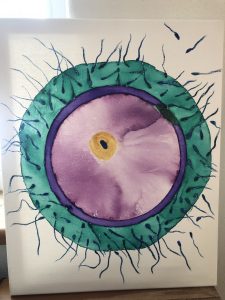
Spermatozoa binding process starts with the formation of the ZP. The Zona Pellucida is a thick extracellular matrix that surrounds a developing oocyte. It is made from secretions that the oocyte ejects to surround itself. The Zona Pellucida has many roles besides just spermatozoa binding (shown in painting). It has a major role in premature implantation as well. The ZP is what the oocyte uses for communication between the follicle cells and itself. When communication errors occur, this can be a reason for early implantation in a place where it is not supposed to implant, like the fallopian tubes, causing an ectopic pregnancy. The picture I painted is showing how the sperm come in contact with the ZP. The ZP, when it is mature, is like a meshi material. Some sperm can get in, and some get stuck inside the mesh that is acting like a filter. The ZP is made up of different proteins, one of the proteins acts as a type of sperm receptor that only lets sperm bind after the inhiation of acrosome reactions. Only sperm that have reacted with acrosome enzyme can fuse with the oocyte, therefore beginning the fertilization process. The acrosome reaction makes the digestive enzymes on the sperms cap release, therefore cutting through the ZP to the egg.

Hayly’s project covers the fertilization process and focuses on the special covering that forms around the oocyte prior to fertilization. This shell is called the Zona Pellucida and is formed from secretions that the oocyte puts off and is made of different proteins. It is through this that the sperm must work through to get to the egg for DNA implantation. The sperm are able to burrow through because of a special enzyme that is secreted by the head of the sperm. Only a few sperm ever make it to the egg and of those few only one gets through to the oocyte. Once one sperm gets through the others are deactivated so that only that one sperm is able to fertilize the egg. Her painting shows a great representation of this interaction between the sperm and the Zona Pellucida.